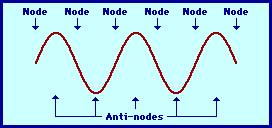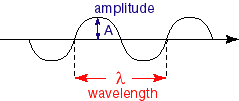|
A wave is a distortion in a material or
medium, where the individual parts of the material only
cycle back-and-forth or up-and-down, but the wave itself
moves through the material. All waveforms have similar
characteristics, and since all forms of wave motion
follow the same laws and principles, knowing the
fundamentals of wave motion is important in
understanding sound, light, and other types of waves.
Some questions you may have concerning
waves are:
-
Exactly, what is wave motion?
-
What are some examples of different
types of waves?
-
What common characteristics do all
waves have?
Definition of wave motion
Wave motion is defined as the movement
of a distortion of a material or medium, where the
individual parts or elements of the material only move
back-and-forth, up-and-down, or in a cyclical pattern.
It appears as if something is actually
moving along the material, but in reality it is just the
distortion moving, where one part influences the next.
This sounds somewhat abstract, but it
can be visualized with examples.
Examples of waves
The following examples shows common
transverse, compression and circular waveforms.
Up-and-down motion creates transverse
waves
At the ballgame, someone in the stands
may start up a "wave" by standing up and then sitting
down. The people on one side then stand up and sit down,
then the next people, and so one.
Everyone is still in their seats, but
the wave traveled through the ballpark from one end to
the other.
You can shake a rope, causing a wave
motion. The parts of the rope only move up-and-down, but
the wave moves from one end of the rope to the other. A
guitar string also has this type of motion.

Vibrating string demonstrates waveform
Light or electromagnetic waves are
caused by a up-and-down motion of electric and magnetic
fields, thus making them transverse waves.
Back-and-forth motion creates
compression or longitudinal waves.
You can stretch out a Slinky along the
floor and give one end a back-and-forth shove. The
compression will move along the Slinky to its other end.
A loudspeaker cone moves back-and-forth
to create a sound, which is a compression wave.
Electrons move back-and-forth in a wire,
sending a wave of electric power through the wire. The
electrons stay in their general region in AC
electricity, while the flow through and out the wire in
DC electricity.
There are cases where the material moves
in a combination of transverse and compression, moving
in a circular or elliptical pattern.
Drop a stone in a pool and waves move
outward. The surface of the water looks like it goes up
and down, but actually the water molecules move in a
circular or oval motion the form the wave.
Light waves
Although light is classified as a
transverse wave, the motion of the electrical and
magnetic fields may be circular instead. It is hard to
tell.
Characteristics of waves
The characteristics of a waveform are
wavelength, amplitude, velocity, and frequency. All
periodic waveforms have these common characteristics.
There are special cases, where only one
crest of the wave is seen, like the the wave at a
ballgame or the sound caused by an impact or explosion.
In those cases, there is still a wavelength, but there
is no frequency, since the waveform is not periodic.
Wavelength is defined as the distance
from one crest (or maximum of the wave) to the next
crest or maximum.

Waveform showing wavelength and
amplitude
The wavelength of an ocean wave is
typically several meters. The wavelength of the
electromagnetic wave used in a microwave oven is in the
order of a centimeter.
The height of the wave is called its
amplitude. Some areas consider the middle of the wave to
its peak as the amplitude, while others consider
peak-to-peak as the amplitude.
Amplitude relates to loudness in sound
and brightness in light.
The velocity of the wave is the
measurement of how fast a crest is moving from a fixed
point. For example, the velocity of water waves can be
measured as their speed in a given direction with
respect to the land.
The speed of sound is about 1000
feet/second. The speed of light is 186,000 miles/second.
The frequency of waves is the rate the
crests or peaks pass a given point. Frequency is the
velocity divided by the wavelength designated as cycles
(or peaks) per second. Cycles per second is also called
Hertz.
Frequency = Velocity / Wavelength
Another way of writing that is:
Velocity = Wavelength x Frequency
Tip: A way to help remember equations is
to look at their units of measurement. If Velocity is in
meters/second, Wavelength is in meters and Frequency is
in cycles/second, then the equation in units would be:
meters/second = meters x cycles/second
The frequency is also the reciprocal of
the time between crests passing a point or the period of
the vibration. With this measurement:
F = 1 / T
Waves are distortions in a material that
may be transverse, compression or a combination of those
movements. Light, sound and AC electric waves are
important waveforms. The characteristics of a waveform
are wavelength, amplitude, velocity, and frequency. |